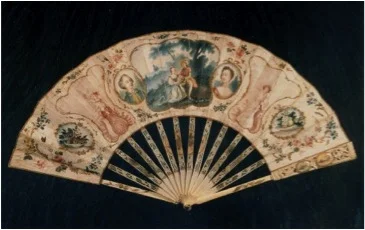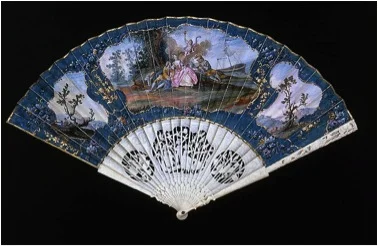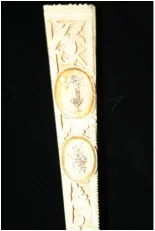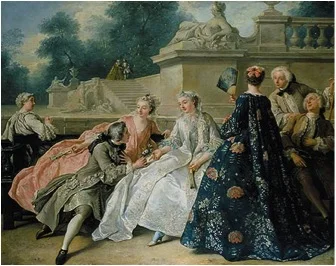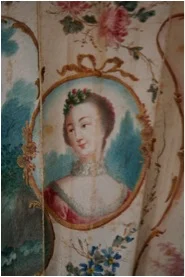A crucial element to eighteenth-century fashion in Europe was attention to detail. From the buttons on one’s waistcoat to the buckles worn on shoes, every aspect of dress conveyed status and was therefore required to be aesthetically pleasing. This concern for detail even extended to accessories, and for women, the folding fan was an important part of the ensemble. Although originally a Japanese invention, the folding fan became widely popular during the eighteenth century. In fact, the fan became so popular that domestic markets adapted this import from the Orient. The exotic fan was eventually transformed into a native, European commodity while still maintaining its luxury status. Similar to the luxury goods of the twenty-first century, the production of the eighteenth-century European fan was a complex process, which included global trade and piecemeal construction. And like any beautiful object, the fan was a reflection of the culture that created and used it. For example, the Marriage Fan, which was made in England c.1750, can be interpreted as a microcosm of eighteenth-century interests including the fascination with the Orient, the Rococo spirit, and the changing notions of marriage.
The folding fan was one of many Asian items adapted by the Europeans. While the men had their banyans (a dressing gown based on the kimono T-shape), the women had their folding fans (a Japanese invention). Both the banyans and the folding fans provided a sense of exoticism, and by owning these articles, the wearer conveyed to others a cultural sophistication that included knowledge of the far away Orient. This spread of interest about the fan from East to West demonstrates the global interconnectedness that existed during the eighteenth century. This transmission was the result of European traders and merchants, especially the Portuguese, who were able to bring back the small portable fan from their travels. However, while the elite were able to afford a fan that was made in China or Japan, there were nevertheless very few fans available in Europe making them all the more expensive. Thus, the demand for fans was met by guilds and workshops in countries such as England and France. And by the end of the eighteenth century, all strata of society could own a fan although quality varied greatly from leafs made from printed-paper to hand painted silk. In the instance of the Marriage Fan, its quality falls in the middle since it is made of paper and the decoration is painted on with gouache.
Because folding fans were all handmade in the eighteenth century, the construction was a complex process. The Encyclopedie by Diderot, an eighteenth-century text that discusses manufacturing and the technical arts, provides insight into the making of fans through illustrations and descriptions of the various steps. For instance, the Encyclopedie describes how a fan leaf was made: after two sheets of paper were glued together, it was stretched on a semicircular frame, and after drying, it was prepared for painting by trimming the paper and establishing pleat lines, and the final step was inserting the sticks into prepared channels.[i] A brief summary of the process of making a fan leaf alone indicates why such a small object required so many skilled craftsmen. In fact, the folding fan was never made by one artisan but rather by one or several workshops. Since France nationalized all of its industries of luxury goods, the guild of master fan-makers was created in which each stage of construction was segregated into skills performed by specialized craftsmen.[ii] Across the English Channel, Great Britain also established a specific company for fan making in 1709 called the Worshipful Company of Fan Makers. Although the English version of fan making was less rigid than its French counterpart, several people were nonetheless required to make a single fan.
With such fan-making workshops and guilds established, the fan industry was booming in both France and England by the middle of the eighteenth century. Even though Europe was now in the business of making its own version of folding fans, Asian influence remained especially when it came to the guard sticks. Most fan makers used guard sticks that were imported from China and were already pre-carved and ready for assemblage with the leaf.[iii] However, the French guilds occasionally did produce their own guard sticks, which were made by either tabletiers or carvers of small ivory objects.[iv] For example, the guard sticks of the Sevres Fan from France, c.1760 were likely made at a French guild since the carving is highly ornate and depicts European dressed figures. In the case of the Marriage Fan, it is likely that the ivory guard sticks were a Chinese import since the English were more interested in using pre-carved guard sticks in order to speed up the construction process. Thus, although Europe made its own version of the folding fan for Western consumerism, its construction continued to be influenced by its Asian counterpart. However, the floral ornamentation found on the surface of the guard sticks, which is in visual harmony with the overall leaf decoration, was probably done in England. Along with the eighteenth-century obsession with detail, another reason for why the guard sticks were often highly decorated through painting and carving was the result of court life. In courtly environments, a fan could never be fully opened in the presence of royalty, and thus fans were often kept closed. The Marriage Fan, with its carved and painted exterior sides of the guard sticks demonstrates how a closed fan could still function as a beautiful accessory and reflect the decoration to be seen when unfolded.
Since fans became so readily available as the eighteenth century progressed, it became increasingly popular for future husbands to present their betrothed a fan as a symbolic gift of their impending union[v] or in other words, a marriage fan. Fans had many symbolic functions especially which it came to eighteenth-century customs of love. Most people are aware of how a language of flirtation was created around the different movements and gestures of one’s fan as subtly indicated in the painting La Declaration d’Amour, c. 1731; in the painting, fan coquetry is exemplified by the lady who is depicted with her back towards the viewer as she gestures with her unfolded fan to the two men. But what happened to the function of the fan after capturing the suitor’s attention? No longer a tool of seduction, the fan became an object of commemoration, a visual celebration of marriage. In the instance of the Marriage Fan, it is unknown as to whether this fan was a betrothal gift from the fiancé or was perhaps used during the marriage ceremony, or both. Any way, the Marriage Fan symbolized a union of love as indicated by the lighthearted imagery of flowers, butterflies, and the central scene of an affectionate couple.
The notion of romance was a somewhat new concept when it came to marriage in the eighteenth century. No longer simply a contract between two families and the continuation of lineage, marriage was increasingly romanticized as indicated by the surviving visual arts from the Rococo era. A favorite daydream of the upper classes in both France and England was to trade city and court life for a pastoral one; the historian Jane Ashelford describes this fantasy as the desire to live in “an idealized landscape wrapped in a golden classical haze.”[vi] Thus, it is logical that an especially popular setting for lovers was an idealized countryside as represented in the English Marriage Fan or in the instance of French Sevres Fan, a “fete galante.” This romanticism of love and marriage is particularly evident in the images painted on both sides of the leaf of the Marriage Fan. In contrast to the more sober inclusion of a family coat of arms, which was often included in betrothal gifts in previous centuries,[vii] the mood conveyed by the iconography of the Marriage Fan is one of Rococo gaiety. Several aspects of the Marriage Fan provide a sense of this lightheartedness such as the soft color palette, a plethora of flowers and vegetation, ribbon framing, and the cherub-like figures in the vignettes that flank either side of the central images. Through the Rococo style and pastoral imagery, the painted decoration of the Marriage Fan conveys a feminine type of romance. This style of romanticism –which was becoming popular in England during the eighteenth century and by the nineteenth century, was commonplace- was increasingly being associated with the celebration of marriage.
Another interesting aspect of the surface decoration of the Marriage Fan is the use of portraiture. It is unknown as to whether the two people depicted within the cartouches were actual portraits of the bride that owned the fan and her groom. Nevertheless, the way that the man and woman are represented within separate roundels relates to the eighteenth-century interest in the miniature portrait. Small in scale and round in shape, miniature portraits were another type of luxury item that was especially popular in England. Miniatures portraits were often incorporated into other items such as fashionable accessories (like bracelets and lockets) and the fashionable interior.[viii]
In examining the Marriage Fan in detail, the general physical and social construction of all European folding fans from the eighteenth-century is revealed. What made European fans like the Marriage Fan so decidedly a product of its time and place was the way in which the fans were decorated and used within the eighteenth-century culture. In the example of the Marriage Fan, the surface ornamentation has Rococo flair while functioning as a symbolic object of an English marriage. For the possessor of the Marriage Fan in 1750, the fan would become a constant reminder of one’s marital union cast in a positive and romantic light. For the owner of the Marriage Fan in the twenty-first century, the fan is a means to gain insight into the culture of the eighteenth century with its love of fashion, romance, and the exotic. In both contexts, the Marriage Fan is more than just an accessory, it is an art object to be folded and unfolded for to be admired by all.
Enjoyed reading? Subscribe to our newsletter.
Ahlstrom Appraisals | Personal Property Appraisals and Art Consultations | Serving Atlanta & Southeast | Fine Art, Antiques & Vintage
[i] Anna Gray Bennett, Unfolding Beauty: The Art of the Fan. The Collection of Esther Oldham and the Museum of Fine Arts, Boston (New York: Thames and Hudson, 1988), 19.
[ii] Philippe Mesmer, Fan Tales (New York: Parkstone Press, 2002), 1.
[iii] Bella Veksler, The Fashionable Fan (Atglen, PA: Schiffer Publishing, 2000), 19.
[iv] Bennett, Unfolding Beauty: The Art of the Fan. The Collection of Esther Oldham and the Museum of Fine Arts, Boston, 19.
[v] Mesmer, Fan Tales, 39.
[vi] Jane Ashelford, The Art of the Dress: Clothes and Society 1500-1914 (New York: HarryN. Abrams Inc., 1996), 123.
[vii] For example, insignias were common on the betrothal chest called cassoni in Italy during sixteenth century.
[viii] Marcia Pointon, “Surrounded with Brilliants: Miniature Portraits in Eighteenth Century England,” The Art Bulletin 83 (2001): 52, 53.
